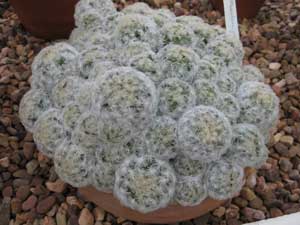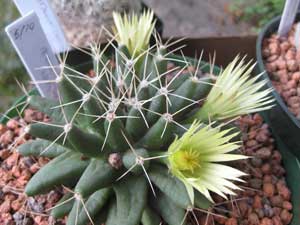Resource Library
Plant of the Week: Nipple Cactus
The University of Arkansas System Division of Agriculture does not promote, support or recommend plants featured in "Plant of the Week." Please consult your local Extension office for plants suitable for your region.
Plant of the Week
Nipple Cactus
Latin: Mammillaria sp.
I like succulent plants because of their sculptural look and the myriad of modifications that have been used to enable these tough and variable plants to survive in xeric environments. Also, they are easy to care for and tolerate my brand of hit-or-miss

maintenance. Cacti, while succulents and certainly interesting, have not garnered as much space on my greenhouse bench, perhaps because of a painful boyhood experience when I sat on a prickly pear patch. But there is one exception – the Mammillaria cacti – of which I grow several.
Mammillaria cacti – now that the Opuntia cacti have been separated into a number of different genera – represent the largest genus in the cactus family, with about 180 species and varieties. They are mostly globular in form, with abundant branching. The globes are usually under 4 inches across with plants seldom taller than 12 inches, so as cacti go, they are well-suited for pot culture and are slow to outgrow house and home. While almost all of the Mammillaria have thorns, the species in commerce tend to be modest and non-threatening.
Mammillaria species are most abundant in Mexico and radiate out in all directions, with a few spilling over into the southwestern United States and Central America.
The multipedaled flowers are funnel-shaped and either with or without a prominent neck to the funnel. Colors are in pastel shades of yellow, pink, red, green and white. They are produced near, but not at, the top of the globe in a circle around the circumference of the body, with one blossom produced from the base of each swollen tubercle that is scheduled to bloom. Individual flowers last one or two days and open sequentially, with plants remaining in bloom for three or more weeks. A nice specimen at the peak of bloom looks like a garland of flowers has been placed around the body of the Mammillaria. The fruits are red, club-shaped berries that are attractive in their own right.
The main feature of the Mammillaria body is its symmetrically and spirally arranged tubercles which, with a good imagination, resemble the female breast. Viewed from above, the tubercles are arranged according to the Fibonancii number sequence, where the number of tubercles increases from the tip of the globe to its midriff. Each descending row of tubercles contains a number that equals the sum of the two previous rows of tubercles. Fibonancii, a 12th century Italian mathematician, figured this sequence pattern out while studying the shells of snails and chambered nautilus, and it has since been observed in many other forms of life.

Areoles, basically a modified node on a typical plant, are the spots on cacti where spines are produced. Cacti spines are believed to be modified leaves, with the oftentimes fuzzy hair corresponding to the stipules found at the base of many typical leaves. Mammillaria and a few closely related genera have areoles with spines at the tip of the tubercle, and then a patch of fuzzy hair at the base of the tubercle. Branching and flower production comes from the fuzz at the base of the tubercle, indicating it is a meristimatic region. This split areole with the tubercle between the terminal spines and the basal tuft is unique to Mammillaria and a few closely related genera. In comparison to typical plants, the tubercles of Mammillaria may be modified petioles.
Many kinds of Mammillaria cacti are available from specialist growers, but mass market retailers are now supplying named species as succulent plants enjoy a modest surge in popularity. Some of my favorite species include the freely branched and fuzzy Mammillaria plumose – Feather Cactus; M. elongata – Golden Star Cactus and its bizarre, brain-like ‘Cristata’ selection; M. hahniana – Old Lady Cactus; M. longimamma – Finger cactus, and others not yet tried.
Mammillaria are slow-growing and easy to grow in average conditions. I grow mine in 4- to 5-inch pots in a commercial peat-based potting mix, which is fertilized in the spring with a slow-release fertilizer. In the summer, they are placed in an outdoor patio area, where they receive bright light but light shade in the heat of the afternoon. Watering is mostly by rainfall, or once every week to 10 days with a garden hose, if no rain has fallen. In the winter, watering is reduced to once a month, with plants kept on a cold greenhouse bench with the heater set on 50 degrees. If you don’t have a greenhouse, place them in a bright, cool location in the home but follow the reduced watering schedule during winter. This period of winter dormancy encourages flower bud development. Blooms appear in late spring or early summer with the return of moisture.
By: Gerald Klingaman, retired
Retired Extension Horticulturist - Ornamentals
Extension News - August 5, 2011
The University of Arkansas System Division of Agriculture does not maintain lists of retail outlets where these plants can be purchased. Please check your local nursery or other retail outlets to ask about the availability of these plants for your growing area.